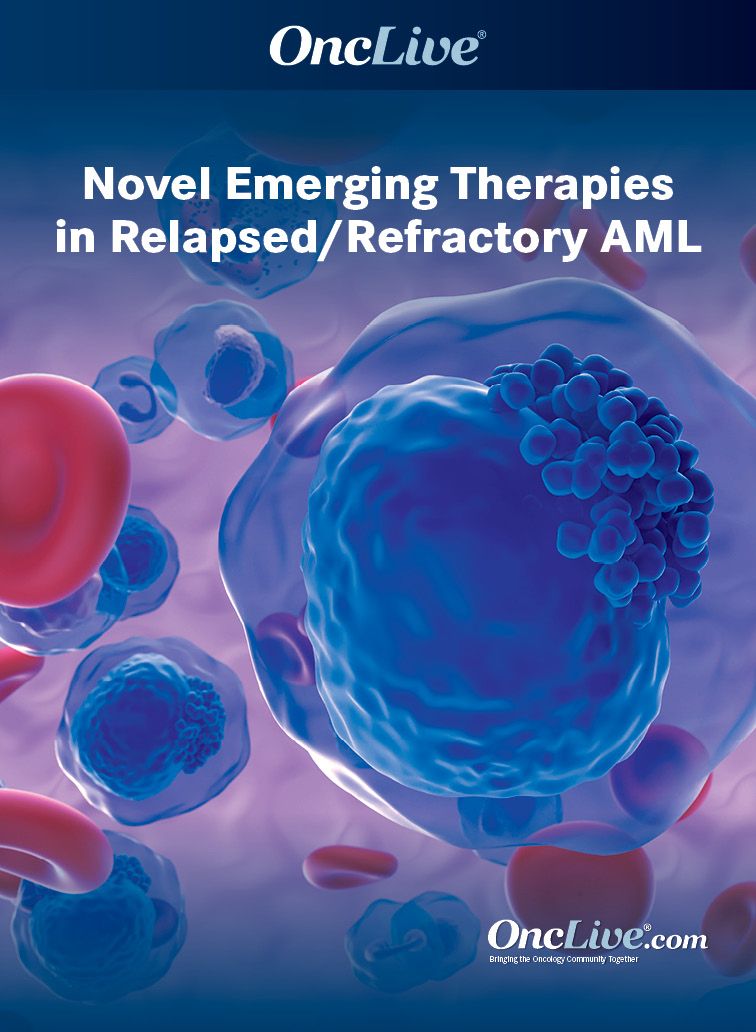Publication
Article
Adding Uproleselan to Chemo Could Reduce Chemotherapy-Induced Mucositis in Relapsed/Refractory AML
Author(s):
Daniel J. DeAngelo, MD, PhD, discusses how the addition of uproleselan to various chemotherapy backbones is being investigated in ongoing clinical trials, plus the encouraging safety data tied to the lowered mucositis levels.
Daniel J. DeAngelo, MD, PhD

The addition of uproleselan (GMI-1271) to chemotherapy reduced the rate of oral mucositis in patients with relapsed or refractory acute myeloid leukemia (AML) in a phase 1/2 trial (NCT02306291), according to Daniel J. DeAngelo, MD, PhD.1
Along with limiting occurrences of mucositis, which is a common adverse effect associated with chemotherapy, DeAngelo said that the uproleselan and chemotherapy combination led to high remission rates and low induction mortality, leading to further investigation in phase 3 trials.
“In one aspect, the addition of uproleselan may be disrupting the leukemia stem cell niche, providing, or allowing increased cytotoxic killing of the leukemia stem cell,” DeAngelo said. “On the other hand, what it is hypothetically doing is protecting the normal hematopoietic stem cells, which are able to keep the mucosal membrane intact.”
In an interview with OncLive®, DeAngelo, associate professor of medicine at Harvard Medical School, and physician in the Adult Leukemia Program at Dana-Farber Cancer Institute, discussed how the addition of uproleselan to various chemotherapy backbones is being investigated in ongoing clinical trials, plus the encouraging safety data tied to the lowered mucositis levels.
OncLive®: Could you discuss the potential with the novel E-selectin antagonist, uproleselan, which is being investigated in AML?
DeAngelo: E-selectinantagonists are part of the tools we have in our armamentarium to affect the [bone marrow] microenvironment. The microenvironment, or the bone marrow niche, provides a protective area for the leukemia stem cells, and there are a lot of interactions with fibronectin, CXCR4, E-selectin, or cellular glycoproteins, where there is an interaction between the ligand receptor. [This allows] leukemia stem cells to enter quiescence within this bone marrow niche.
[Due to this, the leukemia stem] cells are not cycling. They are quiescent and not going to be affected by cytotoxic agents that are specific for [synthesis] phase. Even when [these cells] are dividing, they tend to have inherent resistance to chemotherapy. [This protective bone marrow niche for the leukemia stem cells] may be a reason why it is harder to eradicate [disease in] patients with AML.
What is the mechanism of action with uproleselan? How does it affect E-selectin in patients with AML?
Uproleselan is an E-selectin antagonist. It interrupts the binding with the E-selectin ligand and the receptor. It does not mobilize the cells, but by disrupting the ligand/receptor interaction, it theoretically, and at least in animal models, allows the cells to cycle so they are no longer in quiescence. Importantly, they are more sensitive to cytotoxic agents, and that had been clearly established in many animal models.
By blocking E-selectin cells in the bone marrow, how does this agent impact the AML cells?
By itself, uproleselan is not going to induce any cytotoxic damage. But by disrupting the ligand /receptor interaction, or the E-selectin pathway, the cells are going to inherently be more sensitive to chemotherapy.
It also may protect the normal hematopoietic stem cells. Though we need to prove it in phase 3 studies, what we have seen in the phase 1/2 studies is lower incidences of mucositis and colitis, and as a result, a decrease in sepsis, with what seems to be an improvement in day 30 and day 60 mortality, which may be an added benefit of this molecule.
How does uproleselan work with chemotherapy to amplify the effectiveness against AML cells?
The idea in the phase 1/2 clinical trials was that as a single agent, uproleselan does not provide any cytotoxic killing. By disrupting the leukemia stem cell niche within the bone marrow cavity, the [chemotherapy regimen] being applied plus uproleselan will allow for an increased cytotoxic killing.
[That hypothesis] needs to be tested in a phase 3 fashion. What we presented in the phase 1/2 study was safety [data]. There was no toxicity, or no added toxicity, with the addition of uproleselan and it seemed to have some benefits in terms of having a high response rate, duration of remission, and lower day 30 and day 60 mortality, with a reduction in [the number of adverse effects] of mucositis, colitis, and sepsis.
How did uproleselan impact the occurrence of mucositis in that phase 1/2 trial?
The addition of uproleselan to the chemotherapy regimens that were tested [MEC and 7+3 resulted in] lower incidences of mucositis. The hypothesis is that it protects the normal hematopoietic stem cell.
In animal models, where you give high doses of a nucleoside analogue, oftentimes fluorouracil, if you add an E-selectin antagonist, you can protect the mucous membranes. The hypothesis is that normal hematopoietic stem cells, which are important in keeping the milieu of the mucosal membrane, are kept intact.
Looking towards the future, there are two phase 3 trials examining the utilization of uproleselan in relapsed/refractory AML. Could you provide an overview of what these trials may entail?
The manuscript that was published recently in Blood documented the phase 1 dose-escalation [trial], both in relapsed/refractory AML, as well as newly diagnosed AML. In a dose-escalation fashion, it was found that all dose levels were safe. We were able to have a recommended phase 2 dose [of uproleselan] that we then took into the [phase 2 trial] in a [cohort of patients in the] relapsed/refractory setting [in combination with] MEC chemotherapy. [Additionally, uproleselan was used in a cohort of] untreated elderly [patients with] AML in addition to standard-dose 7+3 chemotherapy..
One phase 3 trial [NCT03616470], led by GlycoMimetics, is an international study in relapsed/refractory AML. These patients had to fail at least 1 anthracycline regimen and could be in either first or second relapse. This is testing the addition of uproleselanin a double-blinded, phase 3 fashion with 2 chemotherapy backbones: MEC, which is what we used in the phase 1/2 trial, or fludarabine, cytarabine and idarubicin. We did not use granulocyte colony stimulating factor [G-CSF] because the safety concerns of adding G-CSF to uproleselan have not been worked out.
That study has met its accrual, despite the COVID-19 pandemic. We are waiting for the appropriate number of events before it can be unblinded.
The second phase 3 study [NCT03701308] is being run through the National Cancer Institute Cancer Therapy Evaluation Program, and the Cooperative Group Alliance is the lead cooperative group for the study. Geoffrey L. Uy, MD, is the principal investigator. This is a phase 3 study in patients over 60 years old with untreated AML receiving standard dose 7+3 chemotherapy, and patients are randomized between uproleselan or [chemotherapy alone]. This is not a blinded study, and patients then could receive consolidation chemotherapy, with or without uproleselan, depending on the randomization.
There is a double end point to this study. The first end point, which was just accrued to, looks at event-free survival [EFS]. This study was halted while the EFS is being analyzed. If positive, then the study will reopen and continue to accrue to answer the second end point, which is overall survival.
There is a phase 1 trial (NCT04964505) that is testing uproleselan in combination with venetoclax (Venclexta) and azacitidine. What are the objectives of this trial in terms of testing uproleselan with agents outside of chemotherapy?
[The hypothesis is that] uproleselan augments the chemotherapy cytotoxic killing, and it may provide a protective [barrier] on the mucosal membrane. [Uproleselan] is not chemotherapy-regimen specific. Both phase 3 studies that are being run are using multiple different chemotherapy regimens. The current standard of care for older patients over 75 years or patients unfit for chemotherapy is a venetoclax-based therapy with a low-dose chemotherapy, either azacitidine, decitabine, or low-dose cytarabine.
This phase 1 study [has to prove] that the addition of uproleselan adds no significant toxicity to the current standard of care of venetoclax and azacitidine. Patients are eligible for the study if they are using [treatments] on-label.
The hope is that the disrupted E-selectin ligand/receptor access is able to enhance the activity of the chemotherapy regimen, in this case, venetoclax and azacitidine, and also provide some protective benefit of the mucosal barrier in terms of less sepsis, mucositis, and infections. The phase 1 trial is being run by Brian Jonas, MD, PhD.
With multiple trials utilizing uproleselan, how could it ultimately impact the treatment landscape for AML if they continue to read out positive data?
If one or both phase 3 trials are positive, uproleselan will be an add on. It’s not specific to the chemotherapy backbone. I don’t believe it will be. My hope is that if one or both phase 3 trials are positive, then uproleselan can be used regardless of the chemotherapy backbone in order to disrupt the bone marrow microenvironment, the leukemia stem cell bone marrow niche. This is theoretically why we think that particular patients end up relapsing. If we can disrupt this niche, you could use uproleselan with any chemotherapy regimen.
Reference
- DeAngelo DJ, Jonas BA, Liesveld JL, et al. Phase 1/2 study of uproleselan added to chemotherapy in patients with relapsed or refractory acute myeloid leukemia. Blood. 2022;139(8):1135-1146. doi:10.1182/blood.2021010721










